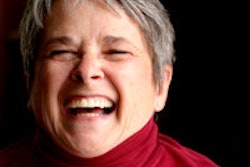
Radiology reports are medical opinions similar to a consultation note by a specialist doctor. They are based on the image interpretation of findings, along with analyzing the clinical history on the request card and taking into account information provided in previous imaging reports, blood results, and knowledge of disease processes. Requesting doctors expect that the clinical question put on the request card to be answered. This was the key message from a large study reported on by AuntMinnieEurope.com on 3 August.
According to the Belgian authors, each report should contain an "impression" section; a precise diagnosis should be given when possible; a differential diagnosis should be provided when appropriate; follow-up or additional diagnostic studies to clarify or confirm the impression should be suggested when appropriate; and any significant patient reaction should be reported.
 Dr. Neelam Dugar is a consultant radiologist at Doncaster Royal Infirmary, U.K., and chair of the Royal College of Radiologists' Imaging Informatics Group.
Dr. Neelam Dugar is a consultant radiologist at Doncaster Royal Infirmary, U.K., and chair of the Royal College of Radiologists' Imaging Informatics Group.
From this survey, it is clear that requesting doctors want a radiology report to be of adequate quality. When an abnormality is found, the radiologist must offer a differential diagnosis and recommendations on further management. As specialist doctors, radiologists are providing a medical consultation in the form of a radiology report, which includes image interpretation. This is no different than a medical consultation from a neurologist, cardiologist, or other specialist.
Radiologists undergo full medical training of approximately six years before subspecialization in image interpretation, which is another five years. As part of our training, we must have good multimodality (plain x-ray, ultrasound, CT, MRI, PET/CT, nuclear medicine, intervention, etc.) training. We must be involved in interpretation of images from all medical specialties and all modalities.
This multimodality and multispecialty training is a hugely important part of our subsequent working lives; as radiologists, we are now largely working in clinical teams as generalists with subspecialty interests. We participate in multidisciplinary team meetings (MDTMs), both for cancer and noncancer subspecialties. Here we must review images in light of more clinical information, pathology, and other factors, and play a key role in supporting the appropriate management of the patient.

MDTMs are expensive, but they remain integral to patient care. Regular attendance by radiologists as core team members improves the quality of patient care. These clinical meetings allow radiologists to keep abreast of changes in patient management in the clinical world, and give us feedback on our reports. It also boosts our confidence in providing richer differential diagnoses and advice on management in future reports.
In the U.K., most radiologists' work pattern comprises approximately 25% participation in clinical meetings and 75% proper reporting, interventions, scanning, etc. Clinical meetings are a qualitative measure of a radiology department. Even industry recognizes the role radiologists continue to play in MDTMs, now and in the future.
"As a result of the democratization of imaging, radiologists need to enhance the service they deliver to keep providing value," Sectra noted in an article about the key role for radiology in future healthcare. "One possible way forward is that we will see radiologists with special interests (rather than fully specialized radiologists) participating as key players in multidisciplinary teams."
|
Ultrasound reports: 8 points to bear in mind
|
Requesting doctors and patients expect particularly high-quality ultrasound reports. Ultrasound performance and reporting were traditionally roles for radiologists, but due to the rapid rise in demand, radiologists were unable to cope with the demand. This led to technicians or radiographers/sonographers fulfilling this role -- as the training requirements were less onerous and shorter than those of radiologists.
In the early days, most sonographer-performed scans would be double-reported by radiologists, and I understand this is still current practice in Australia. Initially, the sonographer reports were largely on obstetric ultrasound. These were simple reports, using protocols and based on measurements. However, the continuing explosion of imaging modalities led radiologists to train radiographers in reporting all types of ultrasound scans.
Reporting by sonographers is a very good value when a scan is normal or there are simple incidental findings, such as gallstones, simple kidney cysts, or fibroids. However, when a kidney tumor, liver metastasis, ovarian mass, or other mass is detected, a radiologist's report would be expected to include a differential diagnosis of the likely tumor. It would also need to review the previous available imaging, like a chest x-ray to look for a primary tumor, to analyze blood results (blood tumor markers), and to provide recommendations, such as CT staging, colonoscopy, or biopsy, as appropriate.
Many radiologists would even like to organize the next test, such as a CT or MRI examination, to speed up the patient's management. Due to their rigorous training and single-modality work, sonographers are exceptionally good at demonstration of abnormalities, but often they are unable to respond to a clinical question or provide a tentative diagnosis or a differential diagnosis due to limitations in their medical knowledge.
The patient must not be forgotten in any turf wars between professions. It is important for both sonographers and radiologists to recognize each other's strengths and work together as a team to provide high-quality care for patients who visit ultrasound departments. It is important that scrupulous managers do not pressure sonographers to work beyond their knowledge and capabilities. Patient care and clinical quality of reports must not be compromised with ultrasound reporting.
Dr. Neelam Dugar is consultant radiologist at Doncaster Royal Infirmary, U.K., and chair of the Royal College of Radiologists' Imaging Informatics Group.
The comments and observations expressed herein do not necessarily reflect the opinions of AuntMinnieEurope.com, nor should they be construed as an endorsement or admonishment of any particular vendor, analyst, industry consultant, or consulting group.



















